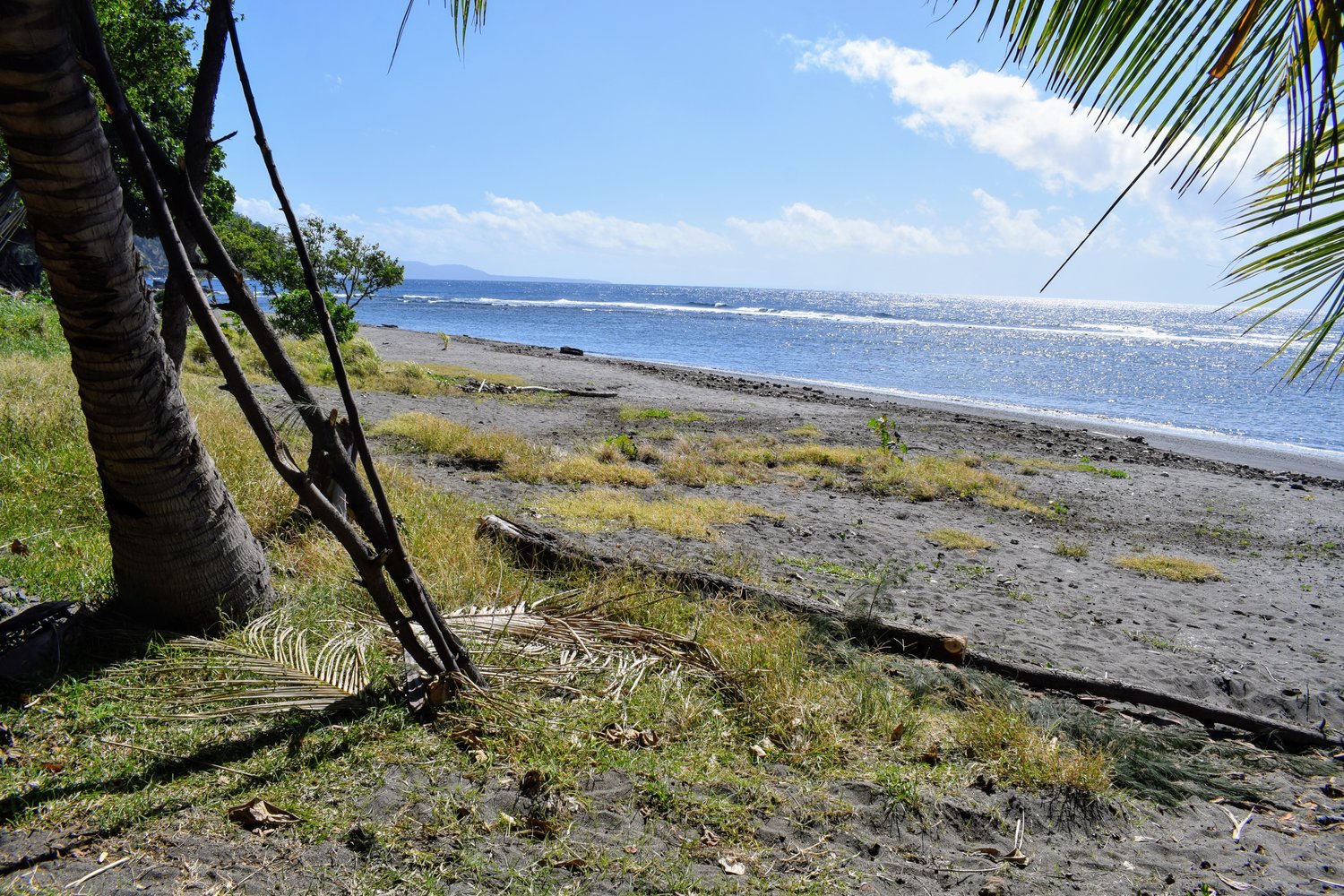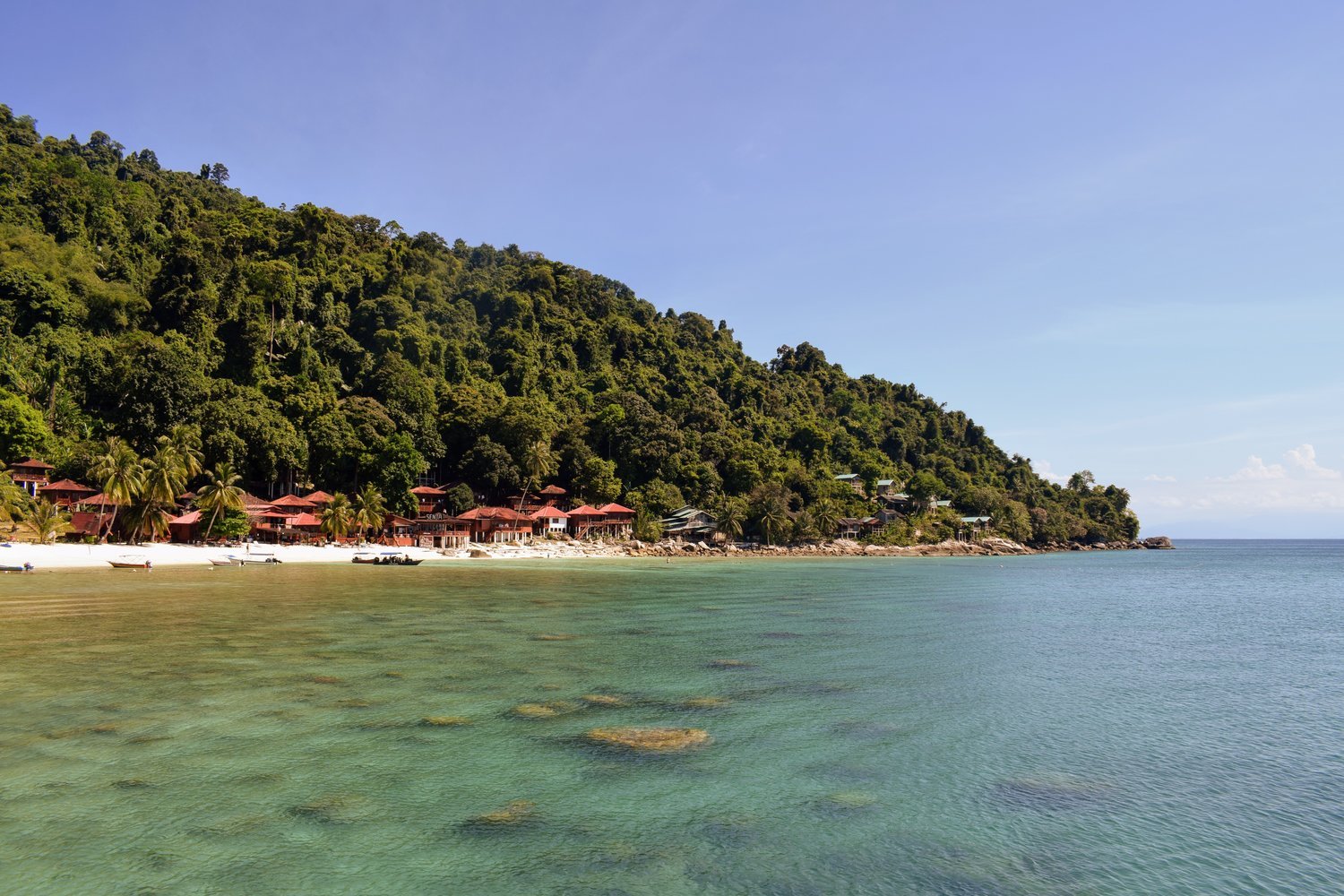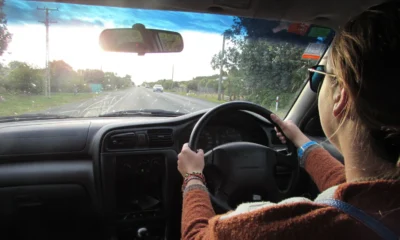Blog
Tongariro Alpine Crossing
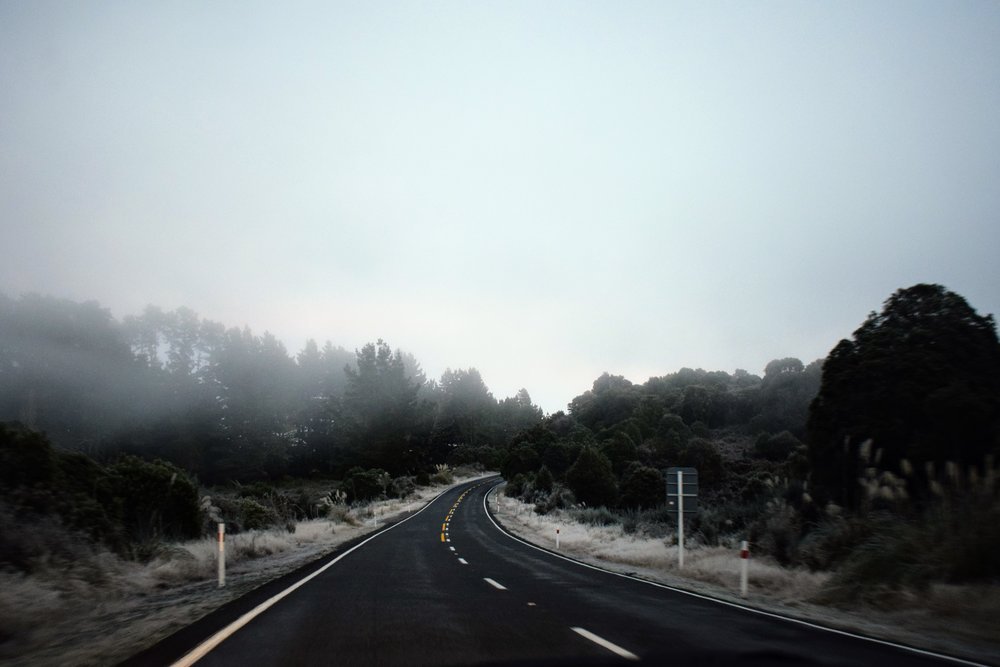
After nearly two weeks driving the circumference of the South Island (again), Emmett and I had taken our car on the ferry to Wellington. We drove around a bit on the North Island before making our way back up to Auckland to reunite with C.J. But it wasn’t just a reunion we had planned – after a little over 24 hours in Auckland, the three of us headed down to the lakeside town of Taupo so that we could hike the Tongariro Alpine Crossing together.
The Tongariro Alpine Crossing is arguably one of New Zealand’s most popular hikes. The Crossing is a 19.4 kilometer (12.1 mile) walk through active volcanic terrain in World Heritage-listed Tonagriro National Park. According to a NZ Department of Conservation (DOC) worker who we spoke to later that day, the track is most popular in the summertime when there can be upwards of hundreds of hikers attempting the crossing each day. I was stunned to hear it because the Alpine Crossing was not an easy hike by any means. In fact, it was not only very long for a “day hike” but it was also quite strenuous – but more on that later.
There was a biting chill to the air that morning in Taupo. That fact, that it was cold, was one of the only thoughts that the three of us could verbalize after waking up at 5:30 A.M. As we started our hour and a half drive to the track’s start at Mangatepopo Car Park, there was a low-hanging spooky fog on the trees outside. We had picked that particular day to do the Crossing solely because the forecast had called for clear skies – for once. I have said it before and I will say it even one more time, to access any of New Zealand’s native abundance of fantastic scenery, you are at the mercy of some very fickle weather patterns. Something to do with being an island over 4,000 km from the nearest land mass… Anyway, this was actually the second time that Emmett and I had been to Taupo. We had visited for a few days last September shortly after first arriving in New Zealand and had been interested in Tongariro but had, of course, been thwarted by the weather. Anyway, the initial fog made us concerned that our visibility on the mountain would be similar.
Luckily, as we approached Mangatepopo, the weather cleared and then (even better!) stayed that way for the rest of the day. The sun came over the horizon and we started the Crossing. The first part was deceptively easy and consisted of a well-maintained gravel trail and then boardwalk-style path as we got closer and closer to Mount Ngauruhoe. Also, if Mt. Ngauruhoe seems familiar to you, it’s because you may recognize it as Mount Doom from the Lord of the Rings film series.

Emmett and CJ at the start of the trail, the easy bit,
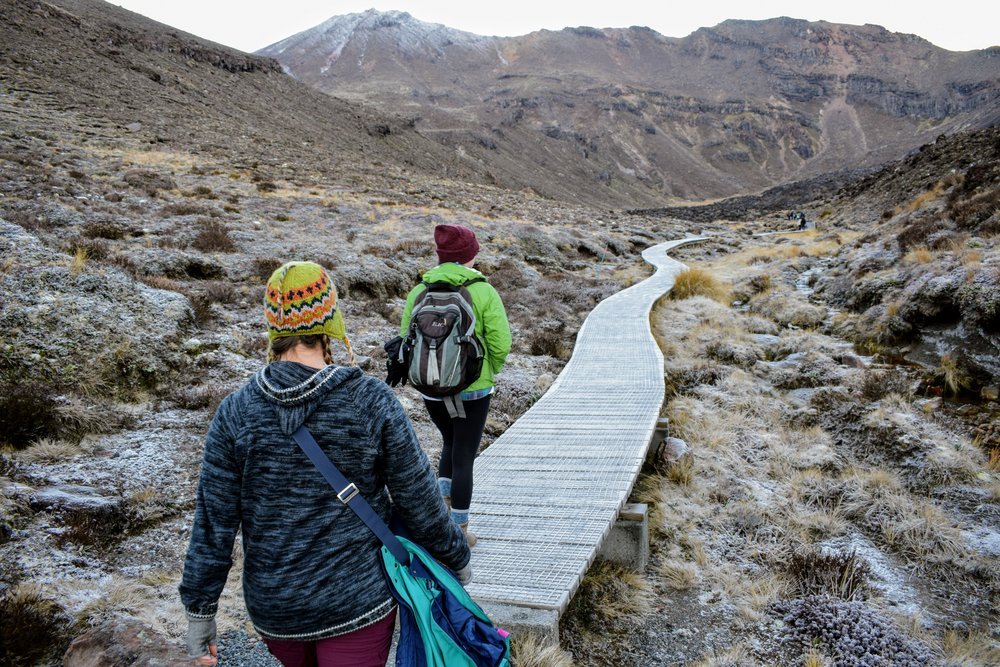
The short boardwalk on the track before the approach to Soda Springs is deceptive: the track only increases greatly in difficulty from then onwards.
We crunched through the icy gravel and up a small incline before we found ourselves at the foot of Mount Ngauruhoe. It was an impressive volcanic cone topped with oxidized iron rocks that gave it a reddish hue. We could see a few miniscule figures loaded with gear making their way up the scree-covered mountainside to the crater. In the summertime, apparently it is possible to make the summit and return as part of a sidetrip from the actual Crossing. Since it was the end of June, aka the shortest days of the year, we reckoned we would not have enough daylight hours to try and do it all. But we certainly enjoyed seeing such a beautiful and dramatic volcano from all the angles below, as we walked on to the South Crater. Also, we were really delighted to find that the sky was clear enough that we could spot Mount Taranaki all the way over on the East Coast, halfway across the country from Ngauruhoe.
The path from Soda Springs to South Crater was one of the more treacherous bits of the Crossing. We had to climb up icy steps with hand chains pegged into the side of the adjacent rock. CJ later told us she had heard that bit was called “The Devils Staircase.” If it had been any icier or the visibility had been any worse, I can imagine that it would be incredibly challenging. Fortunately for us, it ultimately wasn’t even the most difficult part of the track.
The next bit of the journey took us up to the edge of the Red Crater, the very aptly named still-steaming crater that was one of many parts of Mount Tongariro. In fact, technically Mt. Ngauruhoe is part of the larger Mount Tongariro: it’s a parasitic cone. At the top of the Red Crater summit, a friendly DOC sign let us know that we were “halfway” through our hike. I say halfway because I think there estimates are for legitimate hikers because the next half of the crossing took us much longer than the projected time.
After a brief jaunt up the Red Crater’s edge (see above) we found ourselves facing an incredibly steep downhill slope covered in ash and tephra. This was definitely the hardest part of the Crossing, since it was impossible to get solid ground underfoot as you scooted down to the Central Crater of Mount Tongariro. Of the three of us, I in particular kept getting vertigo-like sensations because of the imposing nature of the descent. Have I mentioned before that I grew up somewhere incredibly flat? It’s not in my Florida-girl nature to feel comfortable on steep descents. So I just took my time trying to be as sure-footed as possible – potentially to the chagrin of mountain-siblings Emmett and CJ, though they graciously never mentioned it.
When I finally made my way to the bottom, I was rewarded with a fantastic view of the turquoise Emerald Lakes just off of Central Crater. Apparently, the lakes get their brilliant hue from minerals leeching out of the rocks below Red Crater. Whatever the case may be, they are pretty dang photogenic. I mean, just look at ’em:
After exploring the area around the ice-coated Emerald Lakes, we made the delightfully easy trek across Central Crater. This path was one of my favorite parts of the entire Crossing because the views (which had already been awesome) were the best of all. From across the Central Crater looking back, we could see not only each iconic peak of Tongariro National Park, but also an old lava flow from the Red Crater’s explosion.
From the end of Central Crater, we got one last alpine view: that of the acidic Blue Lake. Quick aside but – is it just me or does it seem like Kiwis love giving things obvious names? North Island, South Island, Blue Lake…? Anyway, it was a lovely light blue that paled (haha…ha) in comparison to the Emerald Lakes but was lovely nonetheless.
After Blue Lake, we got yet another lake view. We rounded a bend on the trail and found ourselves face-to-lake with Lake Taupo. Taupo is itself an old caldera from a supervolcano that erupted just this side of 30,000 years ago. In fact, the area underneath Taupo is still geothermically active as evidenced by fumaroles spewing steam around and across the lake.
The rest of the path is a hangry, frustrated blur, if I’m being honest. We took a zig-zag path down the hillside into native rain forest, which was quite unexpected. By then we’d seen all the different sights there were to see and kept thinking each turn might be the end but it never was. We still had at least an hour’s walk in the forest until we finally reached Ketetahi Car Park at the Crossing’s end. Add that to the fact that I had only had half a granola bar and a carrot to eat and you get a real grumpy gal. I think we were all pretty demolished by the hike by then because the three of us barely spoke. I just kept thinking that if I saw another set of gravel steps in the woods instead of a carpark, I would cry. I nearly did when the steps continued on… and on… and ON. Finally, we did make it.
My frustration was not relieved by finishing, though. I’m sure that Emmett and CJ would say the same. All day, we’d felt pressure to finish the Crossing by 4 PM when it began to get dark (that my friends, is one of the reasons we had an inadequate lunch). Not only that, but we also didn’t have a transportation plan. Our car was parked at the Mangatepopo Car Park nearly 30 kilometers away. Yes, you read that right: further away by road than the hike through the mountains that we’d just done. Emmett and I had previously had a lot of luck hitch-hiking in New Zealand so when we planned our Tongariro Alpine Crossing experience, we figured we could catch a ride with someone back to our car. When we got to the car park, though, we realized that this was not nearly as feasible an option as we had first supposed. First of all, hardly anyone else had a car parked at Ketetahi, as most people aren’t big cheapskates like we are and had splurged for a transport van from one of the many companies in the region offering such a service. Secondly, though we had finished with an hour till sunset, walking out from the car park to the main highway was going to take half an hour minimum. And then we’d be left to take our chances on a wintry remote highway in the dark. Yikes. We were all feelin’ a bit stressed until a very congenial dude with a truck gave the three of us a ride back to our car. Bullet dodged. Thank you hitching karma.
What to Know If You’re Considering Doing the Tongariro Alpine Crossing…
- Be prepared for weather changes!!!!
A) Consider adding a buffer of a few extra days in the area to your plan if you really want to do this track. I’ve heard of so many people who had to wait a bad patch of weather out until the Crossing is safe to undertake. It’s one of the reasons Emmett and I didn’t do it on our first visit to Taupo last year. We only stayed two days and the weather was abysmal.B) The track is 19.4 kilometers across alpine terrain. As you can see from my post above, we were incredibly fortunate to have excellent, clear weather on our hike. Also, if you can tell from our pictures: we really layered up on clothes. I personally started the day with a rain jacket, sweater, a hat, mittens, two pairs of pants, two pairs of socks, and sturdy boots. While I shed various items of clothing throughout the hike, I also ended up putting some back on as the sun began to lower in the sky. At a minimum bring a rain jacket, a hat, a warm base layer, and sturdy shoes (even in the summertime).
- Check the DOC Tongariro page for updates on weather and volcanic activity.
Often if it’s deep into the winter months of July, August, or even early September, DOC will recommend that you not even attempt to do the Crossing without a hired guide (approximately $195 NZD per person). Oh yeah, they also recommend CRAMPONS and ICE AXES. And there could be AVALANCHES. Yes, true winter on Tongariro is a whole ‘nother ballgame. Please, though, no matter what season you go, check out the DOC website to see if there are any warnings that apply to your hike. They also have even more practical recommendations on what to bring with you. - The track is definitely doable but Tongariro Alpine Crossing is not easy if you’re not particularly athletic. Emmett, CJ, and I are all in pretty good physical health but are not in shape. We all felt sore for nearly a week after the hike. And the next day? Phew. I definitely had shin splints and Emmett busted up his knee somehow. The DOC website says they estimate that the track will take between 5.5 or 7.5 hours. It took us about eight hours exactly, with lots of stops for picture-taking. But no lunch break.
- Bring plenty of food and water. We had enough water but not enough snacks/lunch, which was foolish and led to unnecessary hanger. Plus, if for some reason you get stuck and have to wait for a rescue ‘copter – you would probably want food & water in that scenario.
- Tell someone where you’re going!! Whether it’s a friend or family member back home or the staff at your accommodation, let someone know you’re attempting the Crossing so that they can call the rescue service if you don’t make it down the mountain before nightfall.
- I highly recommend doing the track in early winter, like we did. We were able to do the Crossing before any significant snowfall (so no paying for a guide or rental gear) but it was also low season so we didn’t have any of the insane crowds like I’ve seen in friends’ pictures.
- You should probably go ahead and pay for transport back to your vehicle with one of the numerous adventure companies around Taupo & the National Park. Unless, of course, you have friends who also have a car and you want to leave one at Ketetahi and take the other to Mangatepopo to start.
- If you want to experience all the stunning sights but don’t want to bother with figuring out the whole vehicle debacle, you could definitely hike to the Red Crater or even the Emerald Lakes and back to Mangatepopo and not feel as though you missed much. Nobody told me that the last hour (two in our case) is repetitive forest views. If I had a chance to go back, I’d also love to have enough time to summit Mount Ngauruhoe, so consider planning that into your Crossing.
- If you’re feeling especially adventurous, you could stay in either of the huts on the Crossing. Be sure to book ahead online as they can fill up fast. OR you could do the longer, multi-day Tongariro Northern Circuit trek and have a chance to see more of Mount Ruapehu and the National Park.
Blog
Remote Work by the Beach: How the South Jersey and Ocean City Region Can Attract Remote Professionals

Remote work has transformed how people live, choose where to settle, and plan their careers. For many professionals, location is no longer tied to the office. This shift has opened new opportunities for regions like South Jersey and Ocean City, which offer more than scenic beaches. They combine a relaxed lifestyle, strong community values, and improving infrastructure that make them ideal for remote professionals seeking balance between work and quality of life.
This article explores how coastal communities in New Jersey can position themselves as attractive destinations for remote workers, what infrastructure and policies are needed, and how local businesses can benefit from this new wave of digital residents.
The Appeal of Coastal Remote Living and Working
For decades, Ocean City and nearby towns have been known as vacation spots and summer getaways. Now they have the chance to redefine themselves as year-round communities for professionals who work remotely. The appeal lies in their natural assets and lifestyle advantages:
- Peaceful surroundings and access to nature that promote well-being
- Short commutes and reduced congestion compared to urban centers
- A strong sense of community and safety
- Access to restaurants, shops, and recreation without city noise
- Proximity to major hubs like Philadelphia and New York for occasional meetings or events
With high-speed internet and reliable digital tools, working from the beach is no longer a dream. It can be a realistic and sustainable lifestyle.
The Technology That Makes Remote Work Seamless
Technology is the key to making remote work practical and sustainable. For regions like South Jersey and Ocean City, digital tools have made it possible for professionals to live near the coast while staying connected to companies anywhere in the world. These systems help both workers and employers maintain productivity, communication, and compliance.
Some of the most widely used tools include:
- Project management platforms that organize tasks and track progress across time zones
- Video conferencing tools that make it easy for teams to collaborate from any location
- Cloud-based storage and collaboration software that allow secure access to shared resources
- Global payroll management platforms that handle payments and compliance for international employees, ensuring accuracy and reliability for both sides
By using reliable technology and management tools, remote professionals can thrive in coastal communities like South Jersey and Ocean City, where the focus is on quality of life and flexibility without sacrificing professional opportunity.
Building the Infrastructure That Supports Remote Work
Attracting long-term remote professionals requires more than natural beauty. It depends on strong digital infrastructure, housing options, and services that support productivity and convenience. Communities that want to attract remote workers should focus on several key areas:
- Reliable broadband access: Consistent, high-speed internet is essential for video calls, project collaboration, and online business operations.
- Co-working and flexible office spaces: Shared work environments allow remote professionals to network, collaborate, and stay productive outside the home.
- Affordable and year-round housing: Encouraging balanced housing development ensures that workers can live locally throughout the year, not just during peak seasons.
- Community engagement programs: Events, workshops, and professional meetups can help newcomers integrate and feel connected to local life.
- Transportation access: Maintaining efficient routes to nearby airports and major highways keeps the region accessible for both business and leisure.
Several New Jersey towns have already begun expanding broadband networks and converting seasonal spaces into flexible offices. These efforts demonstrate how investment in infrastructure can turn a tourist town into a thriving digital community.
Economic Benefits for the Local Region
The arrival of remote professionals brings steady economic benefits that reach far beyond housing and tourism. When workers relocate full-time, they contribute to local economies year-round rather than seasonally. They support restaurants, service providers, and small businesses that rely on consistent activity.
Remote workers often bring higher incomes from out-of-state employers, which increases local spending power. In turn, this encourages entrepreneurship and innovation in coastal towns. For example, a marketing consultant working remotely from Ocean City may collaborate with a local designer or hire area services for business support. This ripple effect strengthens the entire regional economy.
Creating a Supportive Community Culture
A successful remote-friendly region does more than offer connectivity. It creates a culture that values collaboration, creativity, and balance. South Jersey communities can build this culture by encouraging partnerships between local governments, chambers of commerce, and business networks.
Initiatives that highlight the benefits of living and working in the area can include digital nomad welcome programs, local discounts for co-working spaces, or regional marketing campaigns that promote the lifestyle of working by the beach. Creating online communities for remote professionals can also help connect new arrivals and foster collaboration.
Moreover, remote workers value areas with strong education systems, safe neighborhoods, and family-friendly environments. By maintaining these standards, towns can attract professionals not only looking for scenic views but also long-term stability and growth.
Challenges That Need Attention
While the South Jersey and Ocean City region have great potential, some challenges remain. Seasonal housing costs can rise sharply in peak months, limiting availability for permanent residents. Infrastructure improvements, especially broadband expansion, can take time and investment. Additionally, communities must balance the needs of remote professionals with preserving the coastal character that makes the area special.
Addressing these challenges requires cooperation between local leaders, developers, and community members. By planning carefully, the region can grow without losing its identity.
Looking Ahead: A Coastal Model for the Future of Work
The global shift toward remote work has made lifestyle-based relocation one of the most significant workforce trends of the decade. Coastal regions that adapt quickly will benefit the most. South Jersey and Ocean City have all the elements to become models of how smaller communities can attract skilled professionals who want both productivity and peace of mind.
By investing in technology, promoting community connection, and encouraging inclusive growth, the region can position itself as more than a summer destination. It can become a year-round hub for innovation, creativity, and digital opportunity.
In a world where work can be done from anywhere, the combination of ocean views and a strong sense of community may be exactly what today’s professionals are looking for.
Blog
Reimagine Your Visual Content: DeepSwap AI’s Innovative Approach to Face Swapping
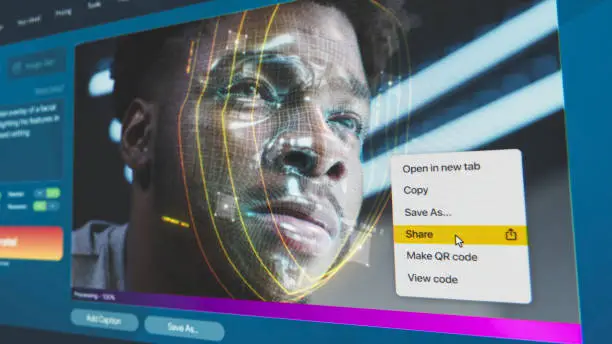
Advanced AI Technology
DeepSwap AI uses cutting-edge artificial intelligence to deliver realistic and seamless face swaps. Its algorithms analyze facial features, expressions, and lighting conditions to ensure that every transformation looks natural and professional, whether it’s a photo, video, or GIF.
User-Friendly Interface
The platform is designed to be intuitive, allowing users of all skill levels to create high-quality face swaps effortlessly. Simply upload your media, select the faces you want to swap, and let DeepSwap AI handle the complex processing. This makes it accessible for beginners while remaining powerful enough for professionals.
Versatile Content Creation
DeepSwap AI supports multiple media formats and even enables multi-face swaps. This versatility is perfect for social media creators, marketers, and digital artists who want to experiment with new visuals, enhance storytelling, or produce engaging content quickly.
Speed and Efficiency
With rapid processing capabilities, DeepSwap AI allows users to generate high-quality face swaps in seconds. This efficiency is ideal for creators who need to keep up with fast-moving trends or produce large volumes of content without sacrificing quality.
Creative Applications
From memes and social media posts to marketing campaigns and digital art projects, DeepSwap AI opens up endless creative possibilities. The platform also includes tools like the girl generator, which allows users to create unique face swaps for character design, creative storytelling, or entertainment purposes.
Privacy and Security
DeepSwap AI ensures that all uploaded content is processed securely. Users retain full control over their data, and the platform encourages responsible face-swapping practices to maintain ethical and safe use.
Conclusion
For anyone looking to elevate their visual content, deepswap ai girl generator offers a powerful, reliable, and innovative solution. Its combination of advanced AI technology, user-friendly design, and versatile features makes it a go-to platform for creative professionals and enthusiasts alike.
Blog
Virtual Birthday Cards: Celebrate Thoughtfully and Easily

We’ve all been there. Morning coffee in hand, you’re scrolling through notifications when it hits you—today’s the day. Someone important to you is celebrating, and you nearly missed it. Racing to a card shop, hunting for stamps, crossing fingers, will it get there in time? That’s yesterday’s stress. Here’s what changed: the digital age handed us something better. You can now mark someone’s special day with authenticity and zero hassle, blending speed with heart.
The Modern Appeal of Virtual Birthday Cards
Digital greetings aren’t just about convenience anymore. They’ve evolved into something richer, offering capabilities that paper simply cannot deliver.
Standard cards run you $4-8 apiece. Tack on postage at $0.60-$1.50. Multiply that across everyone you celebrate monthly and watch the damage add up. Online birthday cards typically cost nothing to maybe $5, with robust premium versions rarely exceeding $10 while offering unlimited capabilities. Factor in the gas you’re not burning driving to stores. Those savings? Redirect them toward meaningful gifts or shared experiences instead.
Instant Delivery Across Time Zones
Think about this: roughly 62% of Americans now have relatives scattered across different states, according to 2023 U.S. Census Bureau findings. Geography becomes a real headache when you’re trying to celebrate someone properly with conventional mail. Here’s where virtual birthday cards change everything. Design something gorgeous at 2 a.m. if inspiration strikes, then watch it land in their inbox seconds later—distance becomes irrelevant. Scheduling tools? They’re standard now. Set it, forget it, and your greeting arrives precisely when you intended. Overseas friends get your love without postal drama or mysterious disappearances in transit.
Environmental Consciousness Meets Celebration
Going paperless cuts waste dramatically. The greeting card industry feeds landfills with millions of tons annually. When you choose digital, you’re celebrating without that nagging eco-guilt. You’re honoring both your recipient and our shared planet. Sustainability used to mean compromise. Not anymore—it actually simplifies your life.
Types of Digital Birthday Greetings for Every Relationship
Now that you understand the benefits, let’s explore what’s actually available. The range might genuinely catch you off guard.
Animated and Interactive Virtual Cards
Movement breathes life into greetings in ways static paper never imagined. GIF-driven designs inject personality and laughs. Certain platforms embed interactive surprises—clickable Easter eggs or mini-games that engage. Background soundtracks establish emotional ambiance. These aren’t just greetings anymore; they’re experiences worth remembering.
Video Birthday Messages
Sometimes animation feels hollow. Video messages deliver genuine face-to-face warmth instead. Film yourself performing their favorite song, reminiscing about inside jokes, or just offering heartfelt wishes. Group compilation features let multiple contributors add clips. Get this: research from Pew Research Center in 2024 indicates 73% of recipients actually prefer video over text-only greetings for milestone moments. AI-generated videos exist too, though nothing beats your actual face and voice.
Collaborative Group E-Cards
Celebrating as a team—whether family, friends, or colleagues—gets amplified through collaborative cards that bundle individual sentiments into something powerfully collective. Everyone adds their unique message, snapshot, or video segment. Your birthday recipient opens one unified card overflowing with affection from numerous sources. This approach shines for workplace celebrations, sprawling families, or community gatherings.
Top Platforms to Send Birthday Cards Online
Understanding your options matters, but actually selecting where to craft your greeting demands platform-specific insight.
All-in-One E-Card Services
Comprehensive hubs bundle templates, customization engines, and delivery controls into single destinations. They usually provide basic free tiers plus premium upgrades. Scrutinize pricing models carefully—some bill per card while others operate on subscriptions. Intuitive interfaces trump fancy features if technology isn’t your strong suit.
Social Media Integrated Solutions
Prefer celebrating where your connections already congregate? Social platforms deliver seamless greeting functionality. Facebook and Instagram supply story templates and direct message card options. These excel for casual acquaintances. Privacy settings let you toggle between public posts and private sharing.
Creating Personalized Birthday E-Cards That Resonate
Finding the right platform launches your journey, but designing truly unforgettable cards demands deliberate personalization strategies.
Design Principles for Maximum Impact
Color psychology drives emotional reactions. Warm palettes—reds, yellows, oranges—broadcast excitement and vitality. Cooler blues and greens whisper tranquil celebration. Font selection carries weight too. Whimsical typefaces suit younger crowds while refined scripts complement formal connections. Visual hierarchy guarantees your core message captures attention first.
Customization Elements That Add Personal Touch
After establishing solid visual groundwork, adding personal flourishes elevates generic templates into treasured mementos. Import photographs capturing shared adventures. Numerous platforms provide custom illustration utilities. Handwriting-style fonts make digital birthday greeting texts feel intimate and deliberate. Voice note integration introduces another personal layer. These details prove you invested genuine thought beyond mechanical “send” clicks.
Message Crafting Techniques
Visual customization establishes the foundation, but your actual words create the emotional resonance recipients carry forward. Calibrate your tone to match the relationship dynamic—absurd jokes for tight friends, warm professionalism for office connections. Blend humor with genuine sentiment. Factor in cultural awareness when addressing diverse contacts. Respect digital attention spans by staying concise.
Timing and Delivery Optimization
Even stunning personalized birthday e-cards lose their magic arriving at awkward moments. Getting timing right proves essential.
Scheduling Features for Perfect Arrival
Pre-scheduling eliminates forgotten celebrations. Most services let you queue cards weeks beforehand. Alert systems ping you before critical dates approach. Some platforms offer multi-event planning for managing numerous celebrations annually. This automation strips away the anxiety of maintaining thoughtfulness.
Last-Minute Emergency Options
Life happens. Birthdays slip through despite your best planning. Knowing emergency protocols prevents celebration catastrophes. The quickest platforms push delivery within literal minutes. Rapid customization templates demand minimal effort. Express design tools help you assemble something meaningful fast when you send birthday cards online with barely hours to spare.
Enhancing Virtual Cards with Digital Gifts
Sincere cards generate emotional impact, but combining them with digital gifts elevates your gesture into a complete celebration package.
Integrated Gift Card Options
Numerous platforms allow attaching e-gift cards directly. Major retailers integrate smoothly. Custom denominations fit any budget. This streamlined approach means your card and gift arrive together as one thoughtful delivery.
Experience and Subscription Gifts
Gift cards offer convenience, sure, but experience-based presents create enduring memories that extend birthday happiness beyond that single day. Think streaming subscriptions, online course vouchers, or virtual event passes. These selections demonstrate you genuinely understand their passions and interests.
Security and Privacy Best Practices
Creating accessible, inclusive cards means nothing if the process jeopardizes sensitive personal details. Protection isn’t optional—it’s fundamental.
Data Protection When Sending Online Birthday Cards
Verify platform security credentials before entrusting them with your information. Understand their data handling protocols. Payment security should satisfy industry benchmarks. Legitimate services encrypt transactions and safeguard email addresses from misuse.
Recipient Privacy Considerations
Securing your own data proves critical, but honoring your recipient’s privacy preferences shows genuine consideration and respect. Select platforms providing private delivery mechanisms. Not everyone wants birthday acknowledgments broadcast publicly across social media. Respect those boundaries without question.
Common Questions About Virtual Birthday Celebrations
Can I schedule cards months in advance?
Absolutely. Most services support scheduling anywhere from 3-12 months ahead. Premium tiers frequently offer unlimited advance scheduling, letting you configure an entire year’s worth of birthday reminders and automated deliveries in one sitting.
Do virtual cards work for elderly recipients?
They absolutely do. Select platforms featuring straightforward interfaces with clear directions. Video messages help less technologically comfortable recipients feel genuinely connected. Most platforms enable email delivery, which the majority of seniors navigate comfortably.
Are free platforms good quality?
Many free alternatives deliver gorgeous designs and fundamental customization capabilities. Paid versions typically unlock features like scheduling automation, video integration, or premium template libraries. Free platforms perform beautifully for casual celebrations.
Final Thoughts on Digital Birthday Celebrations
Contemporary celebration technology makes thoughtfulness accessible regardless of geographic distance, financial constraints, or time pressure. You can forge meaningful connections in minutes rather than burning hours. Digital approaches don’t sacrifice authenticity—they amplify it through personalization and instantaneous delivery. Whether you’re celebrating colleagues, relatives, or friends, these platforms demolish barriers to expressing genuine care. The technology serves your sentiment, never the reverse. Start exploring your options today and experience how effortlessly you can illuminate someone’s special moment.

 Blog10 months ago
Blog10 months agoHow to Deal with Scabies While Traveling

 Travel10 months ago
Travel10 months agoRichmond, Virginia Street Art Guide

 Travel9 months ago
Travel9 months agoPerhentian Islands: How to Get There, What to Expect, & More

 Travel9 months ago
Travel9 months agoHow to Live in Your Car in New Zealand

 Travel9 months ago
Travel9 months agoSouvenir in Nepal: A Guide to Unique Handicrafts and Cultural Treasures

 Travel9 months ago
Travel9 months agoVegan Guide to Dining Out in Richmond, Virginia

 Food9 months ago
Food9 months agoVegetarian Food Nepal: A Journey into Flavorful Plant-Based Cuisine

 Travel6 months ago
Travel6 months agoA Local’s Guide to Sanibel Island, Florida




